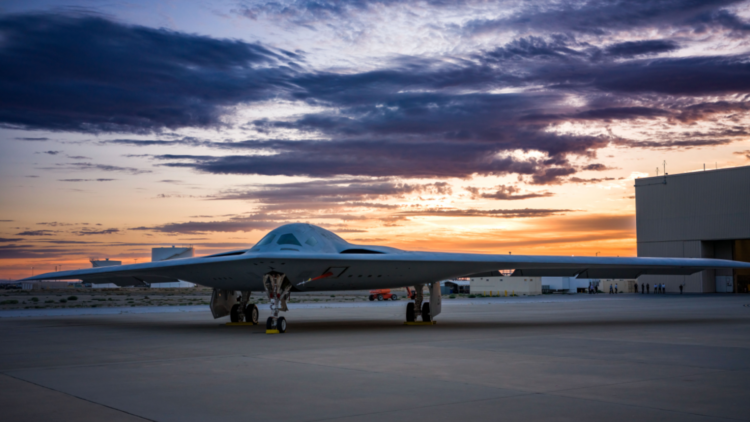In a recent simulation conducted by Chinese scientists, a significant breakthrough in hypersonic missile technology has been unveiled, potentially altering the dynamics of modern warfare and presenting a substantial challenge to stealth aircraft, including the cutting-edge B-21 Raider.
This development could mark a pivotal moment in military defense strategies, indicating China’s leap forward in its capabilities to counter advanced air defense systems.
Let’s take a closer look at the insights made by this simulation, as well as the ramifications of China’s hypersonic missile advancements in challenging stealth aircraft.
Vulnerabilities of Stealth Aircraft Exposed
The study, led by associate professor Chen Jun from Northwestern Polytechnical University in Xian, showcased a compelling revelation: hypersonic missiles armed with cutting-edge features can potentially target and neutralize stealth aircraft like the B-21 Raider.
These missiles, boasting an impressive Mach 6 top speed, displayed the ability to communicate among themselves and coordinate with drones, all facilitated by sophisticated Artificial Intelligence (AI).
The B-21 Raider, a cornerstone of the US Air Force’s Penetrating Counter Air (PCA) strategy, was strategically designed to penetrate China’s sophisticated integrated air defense systems.
Its primary goal is to breach these defenses and launch standoff air-to-ground munitions on crucial facilities such as air defense missile and radar installations, as well as other vital strategic targets on Chinese soil.
Furthermore, the Raider’s potential deployment alongside wingman drones, combined with its advanced Electronic Intelligence (ELINT), Electronic Countermeasures (ECM), and Electronic Warfare (EW) capabilities, is specifically designed to disrupt China’s anti-access/area-denial (A2/AD) strategies.
Chinese Simulation’s Implications
The Chinese simulation suggested that its stealth capabilities might not be impervious to the hypersonic missiles engineered by Chinese researchers.
The simulated engagement revealed the concerning level of adaptability and decision-making agility in the Chinese missile system.
Reportedly, despite the fact that the US aircraft’s cutting-edge sensors detected the original missile launch and quickly maneuvered to avoid the strike, the Chinese missile’s unexpected ability to independently redirect itself toward a secondary target—the B-21’s drone—still caught the US forces off guard.
“In one war game, a B-21-like stealth platform and its companion drone were both shot down by China’s air-to-air missiles, which can reach a top speed of Mach 6,” the South China Morning Post (SCMP) reported.
This surprise operation demonstrated a sophisticated level of target-switching capacity, indicating a significant advancement in Chinese anti-PCA strategy.
Nonetheless, the American strategy remains a significant threat to China’s air defense infrastructure, which relies heavily on radar warning systems across various platforms – land, sea, or airborne.
Adaptability and Precision of Hypersonic Missiles
Crucially, the SCMP report has detailed how these hypersonic missiles, equipped with a novel solid fuel “pulse engine,” could modify power output during flight.
This adaptability enables them to ascend to near space and rapidly descend upon enemy aircraft at tremendous speeds, rendering them exceedingly challenging to evade.
One striking observation from the simulation was the missiles’ agility in target selection.
Even when the US stealth aircraft detected an incoming missile launch and attempted evasion, the Chinese missiles demonstrated unexpected adaptability by autonomously redirecting toward a companion drone of the B-21 Raider.
This capability to switch targets mid-flight caught the US aircraft off-guard, signifying a heightened level of tactical sophistication facilitated by AI-driven decision-making.
Overcoming Communication Hurdles at Hypersonic Speeds
A pivotal hurdle in hypersonic flight has been the “communications blackout” experienced at ultra-high speeds, hindering real-time communication between missiles and ground control.
However, China’s recent strides in high-speed communications technologies offer potential solutions to this barrier.
SCMP reports indicate advancements in terahertz wave-based communication systems, laser systems emitting continuous electromagnetic waves, and satellite-mounted optical switching technologies.
These breakthroughs could mitigate the challenges of maintaining communication with hypersonic missiles during flight, providing China with a potential advantage in executing precise strikes against both aerial and terrestrial targets.
Too Early To Concretely Claim Strength
While these advancements showcase tremendous potential, it’s crucial to acknowledge that several of these technologies might still be in their early developmental stages or confined to theoretical models.
Their full operational integration and effectiveness in real combat scenarios could require further refinement and testing.
Moreover, the evolving nature of defense strategies suggests that both sides are engaged in a technological arms race.
As China makes strides in hypersonic technology, the US and other nations are also likely to intensify research and development efforts to counter such advancements.
This continuous innovation and adaptation underscore the dynamic nature of modern warfare and the imperative of staying ahead in technological prowess.
Shaping Future Strategies: Adapting to Evolving Military Technology
The potential implications of this breakthrough are substantial, as it not only poses a challenge to stealth aircraft but also signifies a paradigm shift in the nature of warfare.
The ability to communicate and redirect hypersonic missiles in real-time, coupled with their remarkable speed and precision, could redefine strategic military operations.
In conclusion, as demonstrated in this simulation, China’s advancements in hypersonic missile technology represent a potential stride toward enhancing its military capabilities.
While these developments highlight possible vulnerabilities in stealth aircraft like the B-21 Raider, they also underscore the urgency for continued innovation in defense strategies and technologies globally.
The future of warfare increasingly relies on cutting-edge advancements, where adaptability and technological superiority will play pivotal roles in determining strategic outcomes on the battlefield.
—
Check out:

